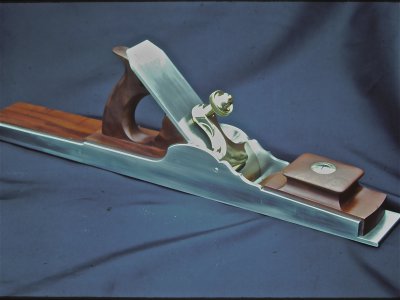- Joined
- Jul 26, 2011
- Messages
- 4,142
This is a 19th.C. style jack plane that I made. It is not a copy of an old plane,but has the style of an infill plane from the late 19th.C..
This plane is about 18" long,and is stuffed with genuine Cuban mahogany. Cuban mahogany is about as hard as ebony,and does not float in water. It is the original mahogany which was highly prized in the 18th. and 19th.C. for fine furniture. It is capable of being carved extremely crisp. I have a closeup of the tote(handle) of this plane. If I can locate it,I'll post it later.
This type of mahogany was logged nearly out of existence,and is not the type of mahogany you can get today. If you can get some,you are fortunate,indeed. Pieces of it sometimes come up for sale,but not often. Sometimes a hurricane in Florida will blow down Cuban mahogany trees,which can be made into lumber. This is very old stock,however. It grew more slowly in the dense forests,and has a deeper color than wood from decorative trees.
This plane is made,like the best originals,by fabricating it from sheets of iron. This was much superior to cast iron,because it would not break if dropped. It was also a much more difficult way to make a plane,and originally these planes cost so much that a shop might own a few which the workmen could use for final surfacing and smoothing,though workmen were expected to have wooden planes of their own.
In this plane,the body is fabricated from 3/16" iron,dovetailed together. The dovetails could be hammered out and spread so that they dovetailed in both directions,and could not come apart. They are nearly impossible to spot on well made metal planes.
The single iron of this plane is 01 steel 3/16" thick,which is,like the body,thicker than is usual for these planes. Everything adds up to greater rigidity,less chattering,and momentum when pushing.
The brass keeper is sawn out of 1/2" brass,and filed by hand to the contours seen.
The cap screw is turned to the high arch and ball on top which I often use. There is convex,old fashioned straight line knurling seen around the base of the knob. I make these antique "microscope" style knurls by running knurl blanks against taps that are being rotated in the lathe. By tilting the blanks a little off horizontal,I can get the "threads to be 90º. By tilting the knurl holder as much as about 20º,I can make "rope" type knurls. One of these days I'll post an article on making knurls. The photos I have are so bad I need to re shoot them.
On the front "bun"of the plane,there is a brass surround around the screw that holds the bun on. Around this brass ring I stamped my name as maker.
I never make the same model plane twice,except for some I cast. I like to design things,and called this plane "the elephant" because of the curves on the body of the plane which are reminiscent of an elephant. And,the weight and mass,too.

This plane is about 18" long,and is stuffed with genuine Cuban mahogany. Cuban mahogany is about as hard as ebony,and does not float in water. It is the original mahogany which was highly prized in the 18th. and 19th.C. for fine furniture. It is capable of being carved extremely crisp. I have a closeup of the tote(handle) of this plane. If I can locate it,I'll post it later.
This type of mahogany was logged nearly out of existence,and is not the type of mahogany you can get today. If you can get some,you are fortunate,indeed. Pieces of it sometimes come up for sale,but not often. Sometimes a hurricane in Florida will blow down Cuban mahogany trees,which can be made into lumber. This is very old stock,however. It grew more slowly in the dense forests,and has a deeper color than wood from decorative trees.
This plane is made,like the best originals,by fabricating it from sheets of iron. This was much superior to cast iron,because it would not break if dropped. It was also a much more difficult way to make a plane,and originally these planes cost so much that a shop might own a few which the workmen could use for final surfacing and smoothing,though workmen were expected to have wooden planes of their own.
In this plane,the body is fabricated from 3/16" iron,dovetailed together. The dovetails could be hammered out and spread so that they dovetailed in both directions,and could not come apart. They are nearly impossible to spot on well made metal planes.
The single iron of this plane is 01 steel 3/16" thick,which is,like the body,thicker than is usual for these planes. Everything adds up to greater rigidity,less chattering,and momentum when pushing.
The brass keeper is sawn out of 1/2" brass,and filed by hand to the contours seen.
The cap screw is turned to the high arch and ball on top which I often use. There is convex,old fashioned straight line knurling seen around the base of the knob. I make these antique "microscope" style knurls by running knurl blanks against taps that are being rotated in the lathe. By tilting the blanks a little off horizontal,I can get the "threads to be 90º. By tilting the knurl holder as much as about 20º,I can make "rope" type knurls. One of these days I'll post an article on making knurls. The photos I have are so bad I need to re shoot them.
On the front "bun"of the plane,there is a brass surround around the screw that holds the bun on. Around this brass ring I stamped my name as maker.
I never make the same model plane twice,except for some I cast. I like to design things,and called this plane "the elephant" because of the curves on the body of the plane which are reminiscent of an elephant. And,the weight and mass,too.


